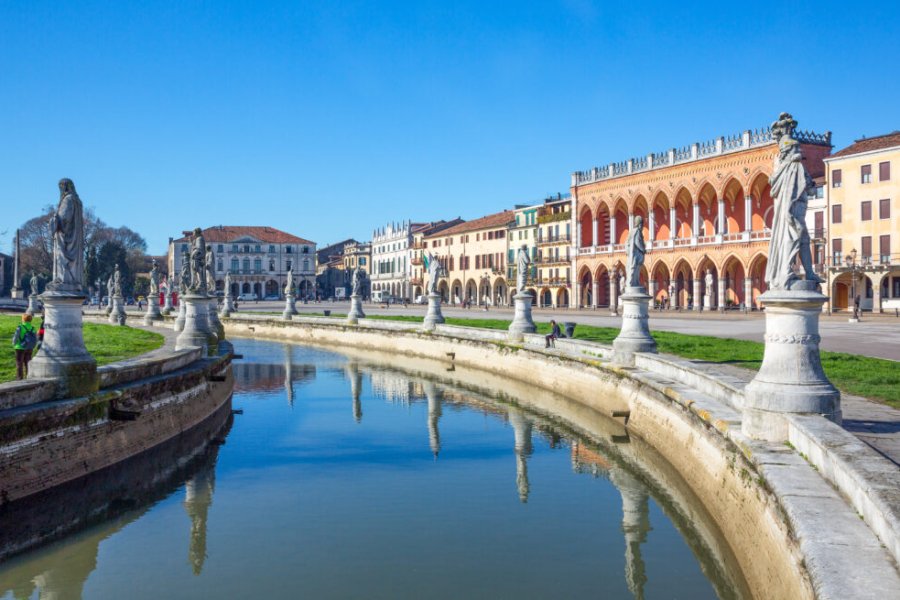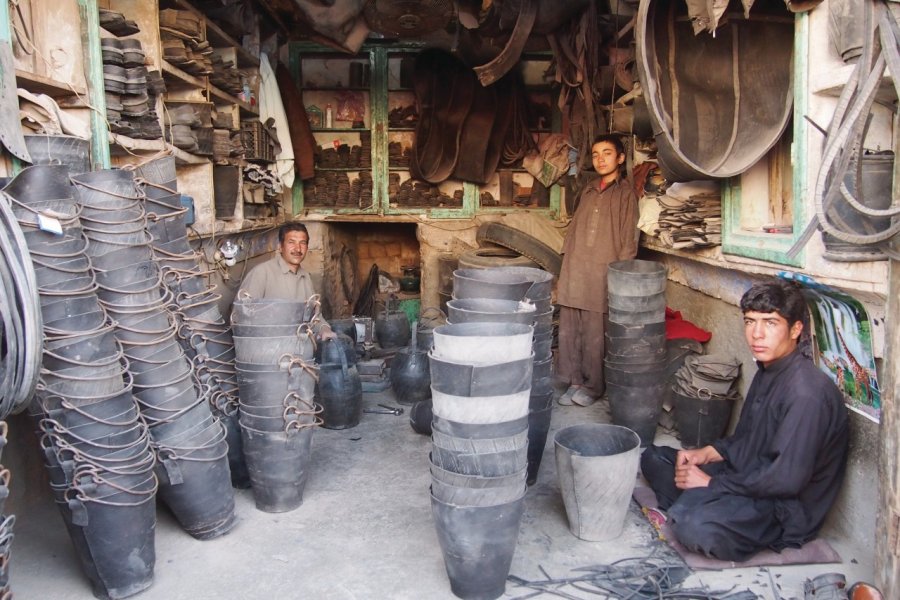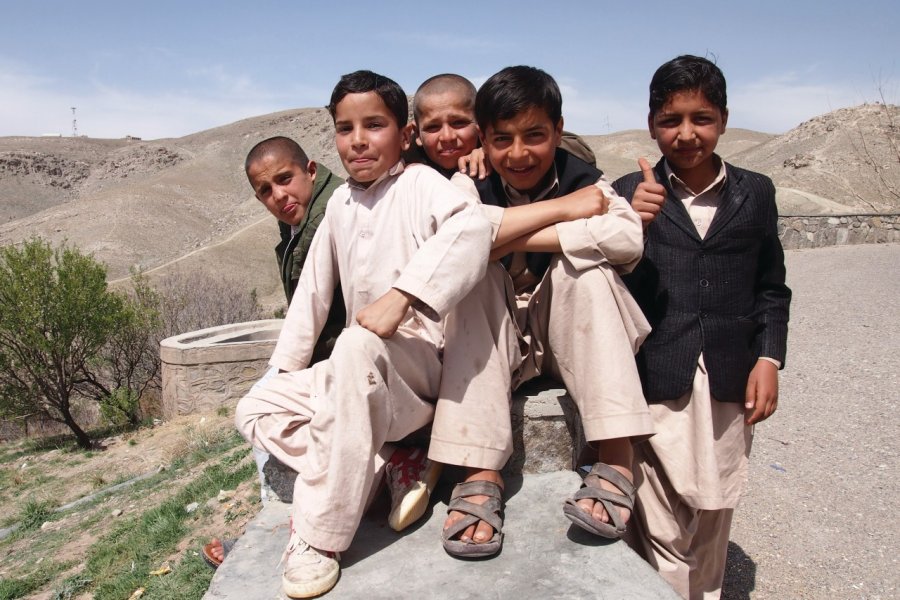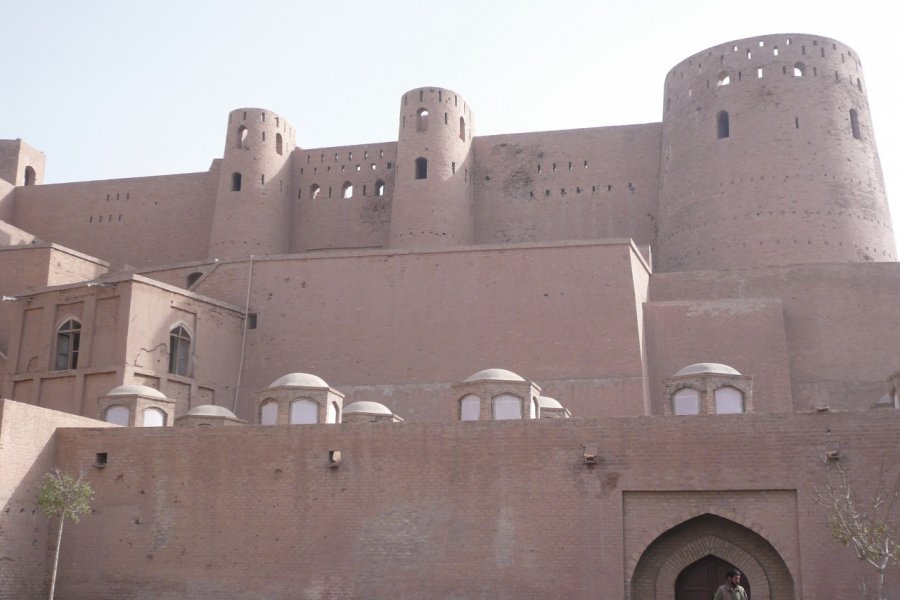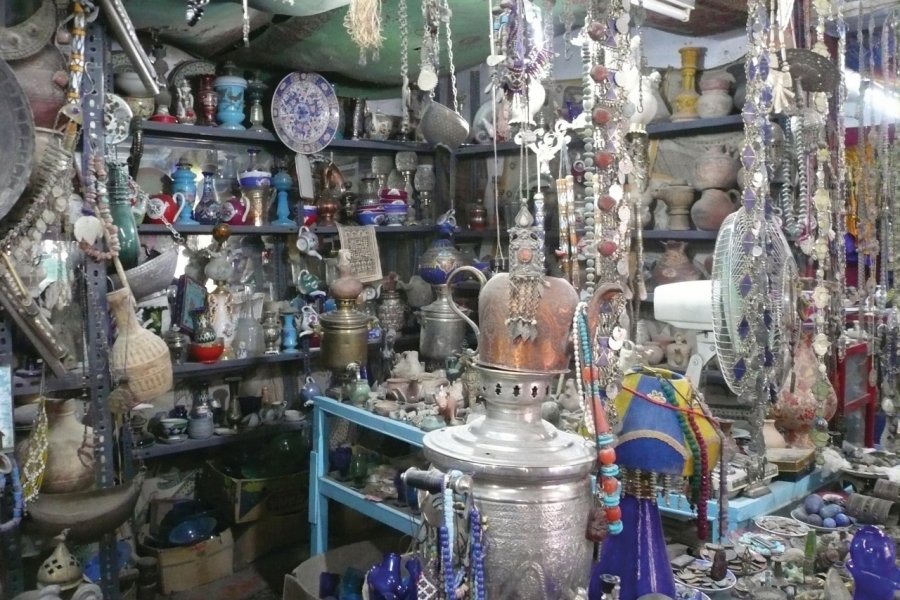Travel Guide Herât
Find an accommodation
Advertising
Hérât was founded 5 000 years ago as a cradle of Afghan history and civilization. It is a surprising city, very different from others visually and fairly modern. From all the cities of Central Asia, it is probably the richest, not only in terms of history and strategic importance, but also through its culture, architecture, painting, poetry and music. The traveller who has already travelled through Afghanistan will be surprised by the modern aspects of this city, such as the existence of «real» paved roads. Unlike other cities in the country, Hérât has electricity 24 h/24 and running water. It also has schools for girls and boys, public parks that are beautifully designed… All thanks to Iran, which invests in that province. The road connecting Hérât to the border was completely redone. Thus, Hérât is a city «to Iran», and the influence of this neighbouring country is more sensitive than that of Afghanistan. It is an oasis of greenery in the desert, surrounded by pine trees and many parks. Hérât is welcoming and gives the desire to stay there. Its inhabitants are hospitals. You will find hotels worthy of this name and varied cuisine restaurants.A third city in Afghanistan in terms of population, the province's capital, Hérât is 650 km west of Kabul. Its borders with Iran and Turkmenistan have earned it a strategic site status and important trade point. She has long practised cotton, grape and fruit trade. To appreciate the atmosphere of the city, you must walk through the maze of its small steep alleyways in ochre colours. Its old wooden doors, magnificent, survived the deterioration of the environment.The local population was converted to Islam very early. Few women here wear burkha, but rather the black veil «to Iran», long and covering only the top of the head. This, once again, reflects Iran's culture. The city is inhabited by many ethnic groups: pashtuns, Persians, Uzbeks, Turkmen, baluchis and hazaras. Many Shi'a have also installed it. Prior to the Soviet invasion, Hérât had 160 000 inhabitants. In the various wars of recent decades, many of the inhabitants of the region have fled to Iran. The Shia chose Iran, while the Sunnis preferred Pakistan. Today, these ancient immigrants return to Hérât. Either because they believe that the situation in the country is improving, or because they are being expelled from Iran. They must therefore be relocated; this is a problem that the municipality of Hérât faces. Makeshift villages were built on the road linking Hérât at the border.The region's habitat consists of small land houses in round domes. This city was the home of a brilliant civilization. The turquoise colours, from the stained bazaar to the mosaics of the mosque, and the chandeliers of its minarets are there to remind you. Called the "Florence of Islam", because of its development, Hérât was one of the country's major cultural and artistic centres. Invaded by successive conquerors, Cyrus, Darius, Alexandre, Genghis Khan and Timur, Hérât has always managed to recover, always showing independence. In the 1930 s, the governor of Hérât undertook extensive urbanization and revamped parks and avenues.Today, the main activities of the city and surrounding areas are based on agriculture and industry. Cotton plantations, rice and wheat crops, carpets and world silk. The Hari Rod Valley is fertile and fertile for cultures.Safety: The town of Hérât is rather calm, although in the region fighting between Taliban and foreign forces continues. The province still had a very deadly attack claimed by the Taliban in April 2012. So we must remain very vigilant. The security situation is changing rapidly, but in 2012 it was still possible to visit Hérât and the sites surrounding it. The city still knows some tensions linked to internal struggles between various political clans.History. As is the case for every city in the country, the foundation of Hérât has given rise to many legends. The best known attribute attributed the appearance of the city and its rapid development to the mythical Iranian kings, Lohrasp, Gushtasp and Baghman. As for the hérati historian, Sayf Ibn Muhammad Harawi, he wrote, around 1300, that the city was built by settlers who, having left Kandahar in the time of King Baghman, sought to settle somewhere. Founded, in principle, in the time of the Assyrian Empire in Mesopotamia, Hérât was known as Haïrava. Alexander the Great entered it for the first time in 330, disguised, apparently, in Persia. He set up a small garrison of soldiers. He destroyed the city and rebuilt it. Hérât then became an essential step, a forced passage for caravans on the silk road.In the th century BC, at the time of the Achaemenid Empire, the city is referred to as Ariana. It is still an important trading centre in Central Asia. In 822, while local power declined, the city fell under the control of an Islamic of the Dynastie dynasty. At the beginning of the th century, Hérât was incorporated into the Samanid emirate, governed by the town of Bukhara. At the end of the 1038 th century, the town moved to the hands of the Ghaznavides and, in, under the control of Selkirk Türk and Torgau Bego. Despite these changes of governments, the city continues to thrive throughout this period. It is renowned for its grandeur and land for their fertility. Everywhere, we talk about its majestic gardens. The sultans ghôrides took the city in 1175.With the arrival of Genghis Khan, the city was devastated. But once again, Hérât quickly rebuilt thanks to its natural advantages, such as the fertility of its soil, the profusion of its water and its position as a shopping centre. In short time, she finds her grandeur past. The walls of the city were rebuilt in the middle of the th century. In 1381, the city was again preparing to suffer. Emperor Timur (Timur) seized power throughout the region. Hérât decided to resist and Timur looting the City. The walls and doors are destroyed again and treasures looted. But, in a few days, Timur realizes the strategic importance of the city and sends his son Mirant Shah to restore it. In 1396 he sent his fourth son, Shah Rush, to govern the Khulusi. Paradoxically, it was the descendants of Timur who returned to Hérât from his ashes. This is the beginning of a period of cultural and artistic flowering, a renaissance, throughout the entire Timurid Empire.In 1404, Shah Rush replaced his father. With his wife Gerhard Shah, he moved the capital of the Samarkand Empire to Hérât. Becoming capital, the city is undergoing a period of architectural, cultural and literary expansion. It's a real site of mosques, public baths, libraries, etc. Painters, scientists, writers, affluent all the empire to exercise their art. Hérât welcomes one of the most famous Sufi poets, Ansari. The latter is devoted to the mysteries of spiritual life. Throughout his life, he will defend the word of God against the theologians and philosophers of his time. It is in reference to this period that we often call Hérât "the Florence of Islam", for its artistic and cultural renaissance. From the whole Muslim world, we come to Hérât. The sumptuous gardens bloom and the inhabitants are grown. Most of this architectural heritage has unfortunately disappeared today. One of the magnificent monuments built at this time is the site of Musalla, a religious college whose minarets still remain. After the death of Shah Rush (1447) and his wife, and the short reign of his son as emperor of Hérât, a period of unrest begins for the Mongol. Sultan Hussain Baïqara (1468-1506) then accesses the imperial throne. With him, the expansion of the city continues. He is known for being one of the greatest princes of the dynasty. It surrounds the best councillors, historians, writers, and Sufi poets like Jami, one of the greatest mystical poets of Hérât and the entire Islamic world. After Sultan Hussain died, Emperor Babur visited Hérât. In 1507, the city was taken by the Uzbeks, ending its brilliant period and its history. But only three years later, the city fell into the hands of the Persians, who held it until the foundation of the Afghan Empire in the th century.In the th and th centuries, Hérât is a semi-autonomous fief led by Pashtuns. So Hérât falls a bit in history. Indeed, the th and th centuries are marked by wreaths waltz and political instability. Until the arrival of Ahmad Shah Durrani, the founding father of Afghanistan, whose power extends from Delhi to Mashad. Hérât regained some stability but quickly became the target of Afghan-Russian wars. Under Abdur Rahman (1880-1901), the "Amir of Iron", Hérât is rebuilt and fortified, and in 1885 monuments such as Musalla are demolished. The British and Russians are interested in the strategic situation of Hérât. In 1931 and 1951, very strong earthquakes shake Hérât and damage many of its monuments.The 1970 s marked his return to the cultural scene. In 1976, UNESCO decided to restore the citadel, but the arrival of the Soviets and civil wars will halt this reconstruction effort. Under the Soviets, a few Russian officers'families come to Hérât. On 15 March 1979, the people of Hérât stood against the Soviets. This urban uprising is unprecedented in Afghanistan. Ishmael Khan stormed the city garrison, killing Soviet and Afghan Communists. Moscow ordered the bombing of the city, bombing in which more than 20 000 Hératis died. In 1992, during the fall of the Communist government of Afghanistan, Ismael Khan, the Lion of Hérât, succeeded in establishing his authority over the province of Hérât. On April 18, he seized the city. Hekmatyar's men try to prevent it by launching offensives on the city. After months of fighting, the Pashtuns of Hekmatyar went to January 1993. The power of Ismael Khan extends to the region of Badghis. The province trade with Iran, restores its ancient niches and sees the return of many refugees to Iran. Ngos such as Handicap International return to the city. Ishmael Khan tries to extend his power to the maximum. But, by approaching too close to the Uzbek areas of the North-West, he faces Abdul Rachid Dostom. So, in May and June 1994, Abdul Rachid Dostom bombed the city. In retaliation, Ismael Khan bombed Mazar-e-Sharif. In July 1994, peace was signed between the two men.As early as 1992, Hérât became a commercial, autonomous place in Kabul. Many goods arrive from Iran. Ishmael Khan collects transit taxes and these large sums of money enable him to rebuild the city. Agreements were signed in the 1990 s with Turkmenistan to provide electricity, petrol and oil resources. Under his reign, children are educated, including girls, and improved health services. On 5 September 1995, the Taliban took Hérât. In February 1995, the Taliban continued their progress and took the provinces of Nimroz and Farah controlled by Ismael Khan. They then move towards the former Soviet base of Shindand. The government is concerned at the inability of Ismael Khan to defend his territory. Massoud's aviation, as well as 2 000 of his Tajik fighters, are being sent back. The Taliban suffer heavy losses and lose the acquired territories.But in September, the Taliban, reset by Pakistan and Saudi Arabia, repoussent the men of Ismael Khan and returned to Shindand. They control the whole western part of the country. The Taliban are closing all Hérât schools and imposing Sharia Law on this non-pashtun population. From time to time revolts broke out in the city against Taliban repression. In January 1997, for example, hundreds of women dressed in burkha marched through the city to protest the closure of steam (public baths). They were then fried with the Taliban water Jet and then mistreated. Moreover, women were no longer allowed to work for international agencies, except in the health sector. Several families have created clandestine schools for their daughters in their homes. Hérât is known, can be more than any other city in Afghanistan, for its constant resistance and its ability to rise even after the most painful events. Just as it was rebuilt after the devastation caused by Genghis Khan and Timur in the th and th centuries, she proved capable of preserving her culture in the face of Taliban repression.Geography. The city of Hérât has approximately 400 000 inhabitants. There would be $ 2 million in the province. Located in the fertile valley of the Hari-Rud River, Hérât is located in a vast oasis of piémont irrigated by this river and its ramifications. Its 300 km 2 of fertile and irrigated land, in a valley with mountains, has the reputation of being the richest in Central Asia. The climate is dry and hot, dominated by the wind of the "one hundred twenty days" or Bad-e-Sad o Bist. As its name indicates, it would blow about 120 days a year from late spring to early fall. Very dusty, it makes the air joke. In winter, it can be very cold. Every year, several thousand people die of cold in Western Afghanistan. The Désert desert is 370 m above sea level. It is 850 km long and is the border with Iran. Hérât was previously a focal point for roads for Balkh, Bamiyan, Bukhara and Kandahar. In the southwest, mountains and plateaus lead to the Désert desert. To the west are the valley and the fertile plains of Hérât, a border town with Iran. This area is irrigated by the Hari-Rud River and, northwest, by the Basins and Farah-Rud. In addition to Hérât, Shindand and Farah are the two agglomerations in this West Afghanistan. Agriculture has a very important part in the economy of Hérât. Wheat and rice have gradually replaced cotton crops. Herodotus described the city as the grenier of Central Asia. Hérât is inhabited mainly by Tajiks. But also from Farsiwans or Parsibans: about 600 000, they speak Farsi and live in Hérât, Kandahar and Ghazni, as well as other cities in the southwest. They are an offshoot of the Shia sect Schia-Imami. The Baluchis live on the side of Hérât and in the Désert desert. They are divided into sub-tribes. They raise cattle, speak the baluchi and are followers of Sunni hanafisme. Dasht-e-Margo, the death desert, is the great desert extending to Iran.
What to visit Herât?
Advertising
Weather at the moment
Advertising
Organize your trip with our partners Herât
Transportation
Book your plane tickets
Car Rental
Boat rental
Accommodation & stays
Find a hotel
Holiday rental
Find your campsite
Tailor-made trip
Immersion travel
Services / On site
Activities & visits
Find a doctor






